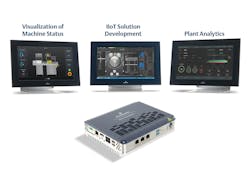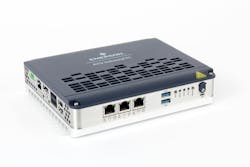Case study: Oil and gas operator implements a new vision to automate and control gas flaring
In today’s rapidly evolving energy landscape, oil and gas operators face increasing scrutiny and responsibility to align their practices with stringent environmental regulations. One of their most demanding, ongoing environmental challenges is efficient management of flaring operations.
Flaring is the controlled burning of excess gases during industrial processes. In the U.S. the Environmental Protection Agency (EPA) is devoting significant resources to improve compliance with established flaring control regulations designed to minimize flare gas burning.
Oil and gas companies that must flare excess gasses are required to visually monitor and manage the frequency and length of time at which flares occur in their operations. A leading oil and gas producer wanted newer, more accurate and automated technology to capture this visual data and efficiently manage it from across its operations.
Its goal: Improve flare smoke monitoring to satisfy environmental concerns, comply with regulations and maximize gas flaring efficiency and cost control across its operations. The company chose the VisionAery Flare Monitoring Solution as its new platform.
Emerson partnered with VisionAery to develop the Flare Monitoring Solution, providing advanced network edge devices and software. The VisionAery solution incorporates the PACSystems RXi2-BP industrial PC and PACEdge software platform from Emerson, leveraging the high-performance edge computing capabilities these systems offer to capture critical flaring visual data and automate mitigation of malfunctioning combustion systems.
Controlling flaring vital to reducing harmful emissions
The EPA defines fugitive emissions as “emissions which could not reasonably pass through a stack, chimney, vent or other functionally equivalent opening.” According to the International Energy Agency (IEA), approximately 140 billion cubic meters (bcm) of natural gas is flared globally each year.[1]
This is a major source of carbon dioxide emissions, methane and black soot, which can damage people’s health and contributes significantly to global warming. The EPA has established extensive regulations to control and reduce flaring in oil and gas operations — at the wellhead, in transmission systems and in refineries and processing plants.
These regulations stipulate flares will be designed to operate with no visible emissions, except for periods not to exceed a total of five minutes during any two-hour consecutive period.[2]
The EPA has established Method 22 for visually tracking and documenting compliance with flaring regulations. Fugitive emissions produced during material processing, handling and transfer operations or smoke emissions from flares are visually determined by an observer without the aid of instruments. This method is used also to determine visible smoke emissions from flares used for combustion of waste process materials.[3]
There are daily, weekly, monthly and quarterly reporting requirements and, at last count, almost 6,300 gas flares in the U.S. Failure to properly monitor flaring and document compliance with the 5-minute/2-hour rule could lead to significant fines and other costs for oil and gas operations. Helping the oil and gas industry sustain compliance with these regulations — and improve the efficiency of the flare monitoring capabilities — is why VisionAery developed the VisionAery Flare Monitoring system.
VisionAery is a leading computer vision analytics provider for the oil and gas industry. It produces segmented computer vision AI at the edge and helps operators streamline processes, autonomously monitor sites for hazardous events and gain detailed snapshot views from alerting and reporting.
The oil and gas operator chose the VisionAery Flare Monitoring system to improve several critical aspects of its operations. Improving its compliance with EPA flare regulations and monitoring was the most important goal.
At the same time, the oil and gas operator is strongly committed to environmental responsibility and needed better technology to promptly identify instances when flares are emitting black smoke. Smoke can indicate incomplete combustion of flared gasses, leading to harmful emissions and potential regulatory violations.
More efficient and cost-effective operations is also a top priority for the oil and gas operator. It wants to use the visual flare data to automate how it fixes gas flaring processes as quickly as possible and minimize the need for manual intervention. Leveraging the edge computing capabilities provided by the Emerson technology in the Flare Monitoring system will help reduce operational costs, streamline flaring maintenance and control, and reduce or eliminate the need for personnel to enter hazardous areas.
Combining AI and video with Emerson edge technology
VisionAery’s Flare Monitoring system seamlessly integrates the company’s sophisticated AI algorithms and computer vision with advanced edge computing solutions provided through the PACSystems RXi2-BP edge server and PACEdge software platform from Emerson.
The RXi2-BP industrial edge device is a compact, ruggedized platform providing mid- to high-range performance for HMI, data recording and analytics applications right at the machine. It helps improve real-time control of operations and better integration into plantwide systems and is engineered to fit the harsh environments common in the oil and gas industry.
PACEdge software gives industrial operators a powerful and flexible platform to securely collect, analyze, store and serve up machine data, both near the data source or efficiently shared across enterprise systems.
With this Emerson edge technology, the Flare Monitoring system dramatically improves the speed and efficiency of the operator’s flare monitoring and control where it is deployed. More than just monitoring and detecting flares, it actively controls key processes to correct flares that are generating smoke and soot. It also saves time, as observers had to drive to each of the 200 flares to check them.
Flare video and telemetry is recorded by the RXi2-BP devices installed across the oil company’s facilities. The telemetry data is captured by the PACEdge platform and delivered via MQTT interface to Node-RED, which controls the camera and data coordination.
This allows the system to instantly detect the presence of black smoke — a telltale sign of incomplete combustion. The video provides opacity data of the smoke to communicate with the flare stack’s blower system through the RXi2-BP edge device. When black smoke is detected, the system automatically adjusts the blower speed to swiftly mitigate the issue. The video and telemetry data is recorded and documented to satisfy regulatory requirements related to Method 22 and the 40 CFR 61 and 63 regulations.
Clearing the air with smarter flare control
The oil and gas industry seeks smarter, more effective ways to monitor flares and control greenhouse gas emissions as part of their efforts to comply with EPA regulations and help combat climate change. With the right technology, processes that were once manual, time-consuming and inefficient can be automated, rapidly intervening to correct equipment malfunctions and reduce harmful emissions.
The oil and gas producer using the VisionAery Flare Monitoring Solution is achieving better, more efficient control of flaring operations. Automated detection and mitigation of improper combustion can yield a substantial decrease in harmful pollutants. This directly impacts the oil and gas operator’s ability to meet corporate emissions reduction and environmental responsibility goals.
The economic benefits of this approach are significant. Automating flare monitoring and mitigation helps the operator deploy workers more efficiently, optimizing resource allocation and site management. Reducing black smoke emissions also helps the oil and gas operator slash operational costs associated with fines, maintenance and excessive fuel consumption.
The Flare Monitoring system also helps improve operator safety. Since the response to the presence of black smoke automates the blower speed adjustment, personnel do not need to enter hazardous areas to inspect or adjust flue and blower equipment, helping promote a safer work environment.
A catalyst for change
The VisionAery Flare Monitoring solution is more than just technology; it is a catalyst for change in the oil and gas industry. Addressing fugitive emissions as well as the emissions that are necessary to transport, store and process petroleum and natural gas is one of the most significant environmental and infrastructure challenges the industry faces.
Technology such as the Flare Monitoring Solution can deliver actionable data and efficient, automated responses to relentlessly reduce the release of greenhouse gases to the minimum necessary for successful operations.
This solution provides realistic cost savings, greater operational efficiency, enhanced safety and environmental responsibility — all while ensuring compliance with EPA regulations. Emerson is committed to collaborating with innovative partners like VisionAery to find new ways to use our smart, agile edge devices, advanced software platforms and other technology to help the industry find better, more effective solutions to critical industry challenges.




